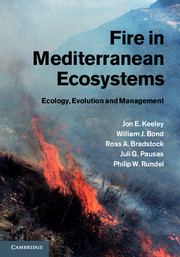3 - Fire-related Plant Traits
from Section I - Introduction
Published online by Cambridge University Press: 05 January 2012
Summary
As illustrated in Fig. 2.1 there are four environmental parameters that are necessary to determine the distribution of fire-prone ecosystems. However, they are insufficient to predict ecosystem responses to fire without a detailed understanding of the fire regime (see Fig. 2.7). Different fire regimes have very different potentials for recovery and place very different premiums on specific plant traits. For example, those traits contributing to the persistence of species in crown fire regimes will often be very different from those in surface fire regimes. In short, organisms are not adapted to fire per se, but rather to a particular fire regime. Plant traits that are adaptive in fire-prone environments are discussed here. The evolution of such traits and the extent to which they represent adaptations to fire are considered in Chapter 9.
Plant populations exhibit four modes of recovery following fire:
endogenous regeneration from resprouts or fire-triggered seedling recruitment,
delayed seedling recruitment from postfire resprout seed production,
delayed seedling recruitment from in situ surviving parent plants, or
colonization from unburned metapopulations.
- Type
- Chapter
- Information
- Fire in Mediterranean EcosystemsEcology, Evolution and Management, pp. 58 - 80Publisher: Cambridge University PressPrint publication year: 2011
- 2
- Cited by

